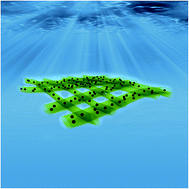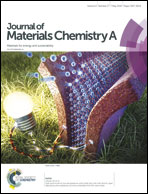A highly flexible and washable nonwoven photothermal cloth for efficient and practical solar steam generation†
Abstract
Solar-driven water evaporation is emerging as a promising solar-energy utilization process. In the present work, a highly stable, flexible and washable nonwoven photothermal cloth is prepared by electrospinning for efficient and durable solar steam evaporation. The cloth is composed of polymeric nanofibers as the matrix and inorganic carbon black nanoparticles encapsulated inside the matrix as light absorbing components. The photothermal cloth with an optimized carbon loading shows desirable underwater black properties, absorbing 94% of the solar spectrum and giving rise to a state-of-the-art solar energy utilization efficiency of 83% during the pure water evaporation process. Owing to its compositions and special structural design, the cloth possesses anti-photothermal-component-loss properties and is highly flexible, mechanically strong, and chemically stable in various harsh environments such as strong acid, alkalis, organic solvents and salty water. It can be hand-washed more than 100 times without degrading its performance and thus offers a potential mechanism for foulant cleaning during practical solar steam generation and distillation processes. The results of this work stimulate more research in durable photothermal materials aiming at real world applications.



 Please wait while we load your content...
Please wait while we load your content...